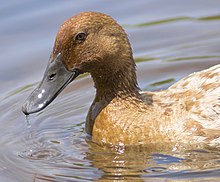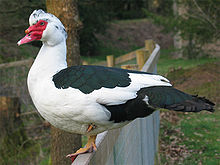
Back بط مستأنس Arabic Pato BCL Качка свойская BE Качкі свойскія BE-X-OLD Ànec xerraire Catalan Kachna domácí Czech Domôcô kaczka CSB Tamand Danish Hausente German Hejmanaso EO
| Domestic mallard Temporal range: Holocene 2,000BC-Present
| |
|---|---|

| |
| Khaki Campbell duck | |
Domesticated
| |
| Scientific classification | |
| Domain: | Eukaryota |
| Kingdom: | Animalia |
| Phylum: | Chordata |
| Class: | Aves |
| Order: | Anseriformes |
| Family: | Anatidae |
| Genus: | Anas |
| Species: | |
| Subspecies: | A. p. domesticus
|
| Trinomial name | |
| Anas platyrhynchos domesticus Linnaeus, 1758
| |
| Domestic Muscovy Temporal range: Holocene – present
| |
|---|---|

| |
Domesticated
| |
| Scientific classification | |
| Domain: | Eukaryota |
| Kingdom: | Animalia |
| Phylum: | Chordata |
| Class: | Aves |
| Order: | Anseriformes |
| Family: | Anatidae |
| Genus: | Cairina |
| Species: | Fleming, 1822
|
| Subspecies: | C. m. domestica
|
| Trinomial name | |
| Cairina moschata domestica (Linnaeus, 1758)
| |
Domestic ducks (mainly mallard, Anas platyrhynchos domesticus, with some Muscovy ducks, Cairina moschata domestica) are ducks that have been domesticated and raised for meat and eggs. A few are kept for show, or for their ornamental value. Most varieties of domesticated ducks, apart from the Muscovy duck and hybrids, are descended from the mallard, which was domesticated in China around 2000 BC.
Duck farming is simplified by their reliable flocking behaviour, and their ability to forage effectively for themselves. Over 80% of global duck production is in China. Breeds such as White Pekin are raised for meat, while the prolific Indian Runner can produce over 300 eggs per year. In East and Southeast Asia, polycultures such as rice-duck farming are widely practised: the ducks assist the rice with manure and by eating small pest animals, so that the same land produces rice and ducks at once.
In culture, ducks feature in children's stories such as The Tale of Jemima Puddle-Duck, and in Sergei Prokofiev's musical composition Peter and the Wolf; they have appeared in art since the time of ancient Egypt, where they served as a fertility symbol.